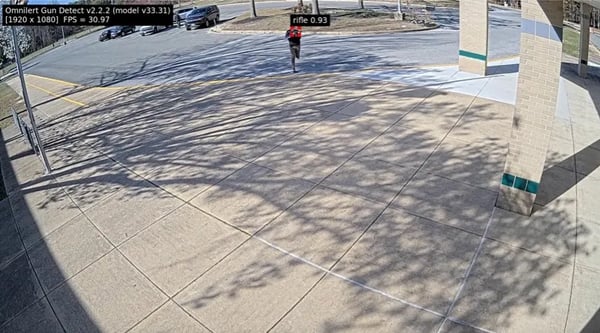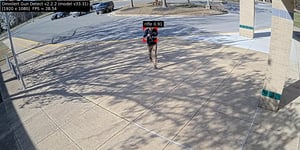Learn why a video clip can make all the difference in real time situational analysis
AI visual gun detection technology is one of the greatest advancements for helping to protect facilities from active shooters. However, when evaluating the different solutions available today, one critical feature often gets overlooked and that is the alert itself. The most common, ubiquitous element of a detection alert is a still image or single frame of video of the suspect with an annotation, usually a box, around the suspected weapon. This image is sent to a phone, desktop computer or other device for human verification. Systems may also provide a capability to zoom in on the image for closer inspection and/or provide additional magnified views of the suspected gun. But one image, one moment within a second, can only provide so much intelligence. Depending on lighting and camera quality, it can be difficult to accurately discern if it is a valid threat or not. In this case, what is a security professional left to do but take the cautious path and alert those in harm’s way and likely put their facility into lockdown and call police.
In contrast, imagine the clarity and context that could be provided if the alert included a video clip in addition to the still image showing the potential threat with more context, including the seconds before and after the initial gun detection. While a picture may tell a thousand words, a video can provide vital context telling you exactly what is going on and giving the intelligence needed to make a confident lockdown decision.
At Omnilert, we pride ourselves on a high accuracy rate with our AI visual gun detection system, but we also understand the need for as much information as possible to make these life-critical decisions. This is why we designed our system to momentarily buffer the video feed locally on the server or appliance running so it can provide both still images and a video snippet with each alert. This gives our customers the accurate information needed before they make a critical decision to initiate a lockdown and robust response.
This video provides an example alert that comes from Omnilert Gun Detect to our mobile app. The same information can also be delivered via text or to desktop computers or other safety systems through a host of off-the-shelf, free integrations. The first frame shows a still image of the potential shooter and suspected firearm, the second image is an annotated close-up magnification of the suspected firearm and who was brandishing it and the final frame provides more visibility and context by showing a short video clip.
Often, the active shooter is spotted from a distance, maybe by a camera at obscure angle or at times of day with inadequate lighting. Making the decision on whether this is a threat might be difficult given those reasons or because the placement of the gun vs. their body or other objects in the background. However, if detection images were accompanied by a secondary close-up image and video showing the suspect, the person viewing the alert would have much more confidence in what they are seeing and if it requires and escalation or not.
Decide for yourself. Would you want to make a decision to initiate a full lockdown looking at only one frame of video?

Omnilert Gun Detect: Multimedia Rich Alerts Combined with High Accuracy Rate
In AI visual gun detection, the word “accuracy” is used in multiple ways. Even before an alert is generated, we rely on the accuracy of the technology to spot a weapon in only a couple video frames. The key to achieving high accuracy comes from the way Omnilert’s AI models are trained. Unlike other solutions, we train our models using 100% organic video footage from actual live settings, both indoors and outdoors, from sources around the world. This means better results versus training models with green screens or using synthetic data.
And once our software detects a weapon, we take ‘accuracy’ to another level, providing both still images and a video clip with the alert to provide as much context as possible to the person who needs to review the alerts and decide whether there is a credible threat.
To learn more about Omnilert and how it provides situational intelligence, refer to these resources:

